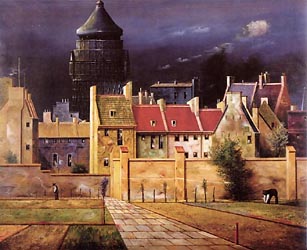|

What is
Magic Realism
To define Magic Realism as it applies to art is both a challenging
and an elusive task. Anyone who embarks on an exploration of this
topic will soon experience feelings of disorientation, confusion or
even delirium. A veritable jungle of references exist for Magic
Realism, but most of the roadmaps charted in its formative period
are outdated. Many trails remain unexplored, while others have long ago
been overgrown.
If Magic Realism exists between the two poles of realism (north) and
pure fantasy (south). We might begin searching for it it somewhere near the
Equator. To
find our way, we will need to invent a metaphysical compass. The
ingredients required for this compass must include artistic sensibility,
acute powers of observation. and knowledge of the
traditions of art history. In art,
we will discover most works in the Northern Hemisphere, typified by
cool, detached compositions, pregnant with metaphors and hidden
meanings. In literature most works will be found south of the
Equator, rich in the mythical and the fantastic.
Magic Realism began to appear in Weimar Republic of Germany around
1920. Its technical roots can be found in the sharp focus realistic styles
as seen in paintings of
the early Flemish, German and Italian Renaissances. The subject
matter
of each Magic Realism work includes both commonplace objects and fantastic elements
drawn from the artist's imagination,
interwoven into a magical fabric. The Magic Realists drew
inspiration from the naive art of Henri Rousseau and the
metaphysical paintings of Giorgio de Chirico. It should be noted
that Magic Realism was the first movement of art to combine fantasy
with everyday reality. Fantasy prior to this time had mainly been
the realm of the mythological or sometimes of religious subject
matter.
The dominant style of art Germany during the twenties is referred to
as Neue Sachlichkeit (New Objectivity). Magic Realism occured when
Das Unheimliche (the uncanny) combined with the realism of Neue
Sachlichkeit. In the second half of this decade, many artists
recognized the trend and added enigmatic elements to their art. The
movement soon spread to other European countries and also to the
Americas.
Magic Realism may be difficult to define, but it is much easier to
survey. We have therefore compiled a Time Capsule, so to speak, of
typical works, chronologically arranged. We invite you to peruse
this gallery and hope that it will provide a better understanding of
Magic Realism, the movement in art.
Magic Realism Time Capsule
email:
dreams@tendreams.org.
|